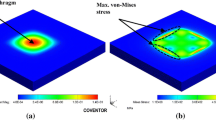Abstract
Polysilicon based pressure sensors use a silicon dioxide layer for isolation of piezoresistors from bulk. This helps in reducing the leakage current compared to the p–n junction isolation in silicon piezoresistors. They are also more cost effective than silicon-on-insulator (SOI) based sensors for high temperature applications. This paper reports the design, fabrication process and characterization of a polysilicon piezoresistive pressure sensor with wet bulk micromachined diaphragm. Novel meander shaped polysilicon piezoresistors are placed at optimized locations, found using finite element method (FEM) simulations, to experience high stress. The effect of clamping conditions of the diaphragm on the piezoresistors placement is shown through FEM simulations and the piezoresistor shapes are designed to keep the metal lines outside the diaphragm structure for better reliability. After fabrication and dicing, the mechanical characterization of the sensor is performed using laser doppler vibrometer (LDV) for determining the first mode resonance frequency and transient response of the sensor diaphragm. A first mode resonant frequency of 306.6 kHz and a response time of 0.56 ms are obtained. The sensor is then packaged inside a customized jig and tested with pressure load for determining the static and temperature characteristics of the sensor in the pressure range of 0–30 Bar. The sensor is tested at three different temperatures, viz. −5, 25 and 55 °C. A sensitivity of 3.35–3.73 mV/Bar, non-linearity of less than 0.3 %, and a hysteresis of less than 0.1 % are obtained for all the test temperatures.

















Similar content being viewed by others
References
Bao M (2005) Analysis and design principles of MEMS devices. Elsevier, Amsterdam
Barlian AA, Park W-T, Mallon JR Jr, Rastegar AJ, Pruitt BL (2009) Review: semiconductor piezoresistance for microsystems. Proc IEEE 97:513–552
Eaton WP, Smith JH (1997) Micromachined pressure sensors: review and recent developments. Smart Mat Struc 6:530–539
Esashi M, Sugiyama S, Ikeda K, Wang Y, Miyashita H (1998) Vacuum-sealed silicon micromachined pressure sensors. Proc IEEE 86:1627–1639
French PJ (2002) Polysilicon: a versatile material for microsystems. Sens Actuator A 99:3–12
Gong S-C, Lee C (2001) Analytical solutions of sensitivity for pressure microsensors. IEEE Sensors J 1:340–344
Guo S, Eriksen H, Childress K, Fink A, Hoffman M (2009) High temperature smart-cut SOI pressure sensor. Sens Actuators A 154:255–260
Herrera-May AL, Soto-Cruz BS, López-Huerta F, Aguilera Cortés LA (2009) Electromechanical analysis of a piezoresistive pressure micro-sensor for low-pressure biomedical applications. Revista Mexicana De Física 55:14–24
Kanda Y (1982) A graphical representation of the piezoresistance coefficients in silicon. IEEE Trans Electron Devices 29:64–70
Kumar SS, Pant BD (2012) Design of piezoresistive MEMS absolute pressure sensor. SPIE, UK 8549
Kumar SS, Pant BD (2014) Design principles and considerations for the ‘ideal’ silicon piezoresistive pressure sensor: a focused review. Microsyst Technol 20:1213–1247
Li X, Liu Q, Pang S, Xu K, Tang H, Sun C (2012) High-temperature piezoresistive pressure sensor based on implantation of oxygen into silicon wafer. Sens Actuators A 179:277–282
Liu X, Lu X, Chuai R, Shi C, Suo C (2009) Polysilicon nanofilm pressure sensor. Sens Actuators A 154:42–45
Maier-Schneider D, Maibach J, Obermeier E (1995) A new analytical solution for the load-deflection of square membranes. J Microelectromech Syst 4:238–241
Malhaire C, Barbier D (2003) Design of a polysilicon-on-insulator pressure sensor with original polysilicon layout for harsh environment. Thin Solid Films 427:362–366
Mukhiya R, Bagolini A, Bhattacharyya TK, Lorenzelli L, Zen M (2011) Experimental study and analysis of corner compensation structures for CMOS compatible bulk micromachining using 25 wt% TMAH. Microelectron J 42:127–134
Senturia SD (2001) Microsystem Design. Kluwer, Boston
Sivakumar K, Dasgupta N, Bhat KN, Natarajan K (2006) Sensitivity enhancement of polysilicon piezo-resistive pressure sensors with phosphorous diffused resistors. J Phys 34:216–221
Smith CS (1954) Piezoresistance effect in germanium and silicon. Phys Rev 94:42–49
Tanasković D, Djurić Z, Lazić Z (1995) Influence of impurity distribution on thermal coefficients of resistivity and piezoresistivity of diffused layers of silicon, 20th Int. Conf. on Microelectron. (MIEL’95), pp 573–576
Wei J, Sarro PM, Due TC (2010) A piezoresistive sensor for pressure monitoring at inkjet nozzle, IEEE Sensors conf., pp 2093–2096
Xiansong F, Suying Y, Shuzhi H, Wei Z, Yiqiang Z, Shengcai Z, Weixin Z (2004) Simulation and test of a novel SOI high temperature pressure sensor, 7th Int. Conf. on solid-state and integrated circuits tech, pp 1824–1827
Zhang Y-H, Yang C, Zhang Z–H, Lin ZH–W, Liu L–T, Ren T–L (2007) A novel pressure microsensor with 30-μm-thick diaphragm and meander-shaped piezoresistors partially distributed on high-stress bulk silicon region. IEEE Sensors J 7:1742–1748
Acknowledgments
Authors would like to acknowledge the generous support of the Director, CSIR-CEERI, Pilani. The authors would also like to thank all the scientific and technical staff of MEMS and Microsensors Group at CSIR-CEERI, Pilani. The financial support by Council of Scientific and Industrial Research (CSIR) through PSC-201: MicroSenSys project is gratefully acknowledged. The authors would also like to thank Dr. S.C. Bose and Mr. M. Santosh from IC design group for their help in sensor characterization. The authors would also like to acknowledge the Centre for Nano Science and Engineering (CeNSE) at the Indian Institute of Science (IISc), Bangalore for providing the LDV characterization facility for mechanical characterization.
Author information
Authors and Affiliations
Corresponding author
Rights and permissions
About this article
Cite this article
Kumar, S.S., Pant, B.D. Polysilicon thin film piezoresistive pressure microsensor: design, fabrication and characterization. Microsyst Technol 21, 1949–1958 (2015). https://doi.org/10.1007/s00542-014-2318-1
Received:
Accepted:
Published:
Issue Date:
DOI: https://doi.org/10.1007/s00542-014-2318-1




